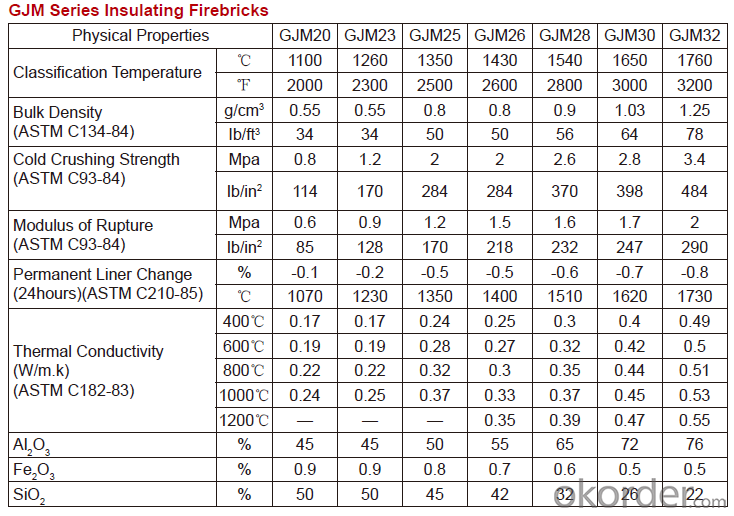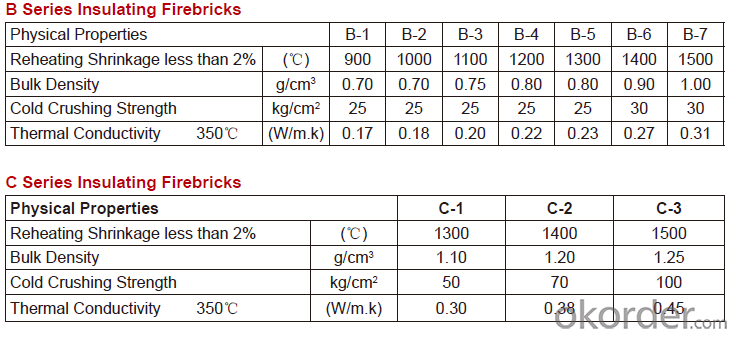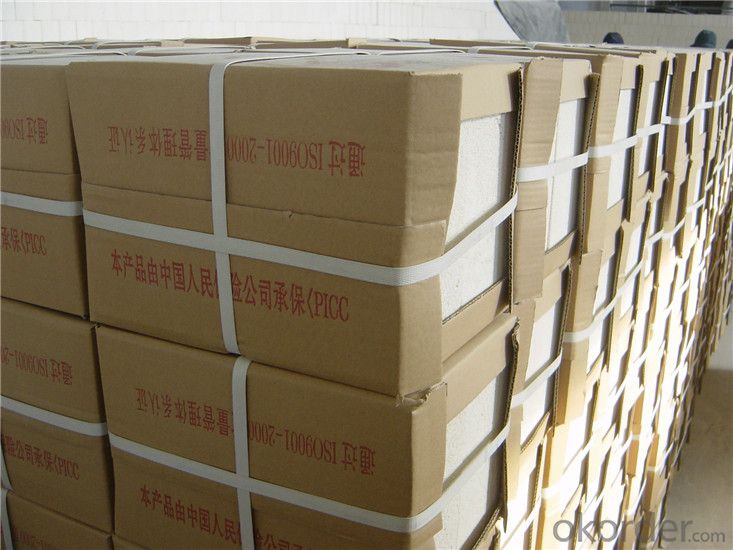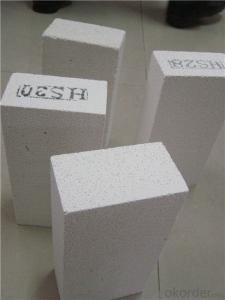High Temperature Refractory High Density Fire Brick
- Loading Port:
- Shanghai
- Payment Terms:
- TT OR LC
- Min Order Qty:
- 1 m.t.
- Supply Capability:
- 1000 m.t./month
OKorder Service Pledge
OKorder Financial Service
You Might Also Like
Thermal Insulation Fire Clay Brick
Refractory brick is a block of refractory ceramic material used in lining furnaces, kilns, fireboxes, and fireplaces.
We provide high quality Refractory Fire Bricks that are used on wide range in the various industries like Cement, Glass and Steel. Refractory Fire Bricks are provided as per the quantity and specifications required by the customers. We provide an extensive range of Refractory Fire Bricks at reasonable prices that depend upon the quantity ordered.
Application
Insulating Fire Brick are used for the lining of converter, alternating current arc furnace, direct Current arc furnace and the ladle slag line, etc.
Company Advantage
(1)Long Insulating Fire Brick manufacture history: 25 years manufacturer
(2)Advanced equipment
(3)Diversification of production standards: ISO ANSI FEPA JIS ASTM
(4)Flexible payment: T/T L/C D/P D/A
(5)Professional marketing team and after-sale service
Insulating Fire Brick main feature:


Equipment
1 unit of Ceramic Abrasive (SG Abrasive) pilot production line
2 units of Compact grain Abrasive pilot production lines
1 unit of high-end coated abrasives (abrasive cloth) production line
2 units of Boron Carbide production lines
3 large flexible crushing and sieving lines for grit production lines
6 units of 5000KVA-10000KVA dumping type electric arc furnaces for Brown Fused Alumina fusion
Q1 What’s the transport method?
A1 FCL delivery goods with wooden pallet or wooden case by sea; If LCL delivery, must with wooden case; Sometimes need open top, flat rack or bulk cargo.
Q2 What’s the required payment term?
A2 Generally 30% TT as the prepayment, 70% TT before delivery. If need, 100% Irrevocable Letter of Credit or negotiation.
Q3 Which country are our products exported to?
A3 Apart from entire Chinese market, the US, Russia, Japan, Korea, Australia and some Southeast Asian Nations.


- Q:Are insulating fire bricks resistant to impact or mechanical stress?
- Yes, insulating fire bricks are resistant to impact and mechanical stress. Insulating fire bricks are made from lightweight refractory materials that are designed to withstand high temperatures and thermal shock. These bricks are specifically engineered to have a high resistance to mechanical stress and impact, making them suitable for various applications where they may be subjected to external forces or pressure. Their structural integrity and durability allow them to maintain their shape and thermal insulation properties even when exposed to mechanical stress or impact, making them an ideal choice for use in furnaces, kilns, and other high-temperature environments.
- Q:Can insulating fire bricks be used in ladles?
- Certainly! Ladles can indeed utilize insulating fire bricks. These bricks are specifically engineered to endure extreme temperatures while offering thermal insulation. They find frequent application in situations where the maintenance or regulation of high temperatures is necessary, like furnaces, kilns, and ladles. Ladles are employed for the purpose of pouring and transferring molten metal or other substances. By incorporating insulating fire bricks into ladles, heat loss is reduced and energy efficiency is enhanced. Moreover, these bricks serve as a safeguard against chemical reactions and erosion stemming from the molten materials, thus qualifying them as suitable for ladle usage.
- Q:Are insulating fire bricks resistant to moisture absorption?
- Yes, insulating fire bricks are resistant to moisture absorption. These bricks are specifically designed to have low porosity, which helps to prevent the absorption of moisture. The manufacturing process involves the use of high-quality refractory materials that are able to withstand high temperatures and resist the effects of moisture. This makes insulating fire bricks an ideal choice for applications where moisture resistance is required, such as in kilns, furnaces, and other high-temperature environments.
- Q:What are the main uses of insulating fire bricks?
- Insulating fire bricks, known as IFBs, are essential for applications requiring thermal insulation and heat resistance in high-temperature settings. These bricks are composed of lightweight materials like clay, silica, and alumina, engineered to endure extreme temperatures. A primary application of insulating fire bricks is the construction of kilns and furnaces. They line the walls, floors, and roofs of these high-temperature devices, delivering insulation to minimize heat loss and enhance energy efficiency. IFBs' insulating properties facilitate consistent and controlled temperatures inside kilns and furnaces, optimizing heating and cooling processes. Furthermore, insulating fire bricks are commonly employed in the construction of chimneys and flues. They withstand the corrosive effects of flue gases and endure the high temperatures produced during combustion. IFBs' insulation prevents heat transfer to surrounding structures, mitigating fire risks and ensuring the safety of chimneys and flues. Moreover, insulating fire bricks are frequently utilized in the manufacturing of fireplaces, pizza ovens, and other outdoor cooking equipment. These bricks retain heat within the cooking chamber, promoting even cooking and reducing fuel consumption. The insulating properties of IFBs also prevent the outer surfaces of these devices from overheating, decreasing the likelihood of accidental burns. Overall, insulating fire bricks are crucial for providing thermal insulation and heat resistance in high-temperature environments. Whether in kilns, furnaces, chimneys, or cooking equipment, these bricks play a vital role in maintaining efficient heating processes, ensuring safety, and conserving energy.
- Q:Is it possible to paint or coat insulating fire bricks?
- Yes, it is possible to paint or coat insulating fire bricks. However, it is important to use heat-resistant paints or coatings that can withstand high temperatures. Regular paints or coatings may not be suitable as they can crack or peel due to the intense heat. It is recommended to consult with a professional or refer to the manufacturer's guidelines to ensure the correct type of paint or coating is used for insulating fire bricks.
- Q:Are insulating fire bricks easy to handle and install?
- Insulating fire bricks are known for their ease of handling and installation. They possess a lightweight composition, enabling effortless transportation and portability. Furthermore, their user-friendly design, in terms of shape and size, facilitates simple manipulation and installation. The majority of insulating fire bricks are equipped with pre-drilled holes or grooves, further streamlining the installation process. Moreover, these bricks offer high versatility as they can be easily cut or shaped to accommodate specific dimensions or requirements. As a result, even individuals with limited expertise or familiarity in masonry work find insulating fire bricks to be manageable and straightforward to handle and install.
- Q:Are insulating fire bricks resistant to warping?
- Insulating fire bricks are known for their resistance to warping. They are specifically designed to withstand high temperatures and thermal shocks, preventing any potential warping. These bricks are crafted using lightweight materials like clay, silica, and alumina, which are combined with additives to enhance their insulation capabilities. Moreover, these additives not only contribute to the brick's insulation, but also aid in its resistance against warping. Furthermore, insulating fire bricks undergo a meticulous manufacturing process that ensures dimensional stability and reduces the risk of warping. It is worth mentioning, however, that prolonged and extreme exposure to high temperatures may still result in some warping, albeit to a lesser extent than other brick types.
- Q:Are insulating fire bricks safe to use in contact with food or beverages?
- Insulating fire bricks are not safe to use in direct contact with food or beverages. These bricks are typically made from materials such as silica, alumina, and other refractory materials that are designed to withstand high temperatures and provide excellent insulation. While they are commonly used in industrial applications like kilns and furnaces, they are not intended for use in food preparation or consumption. Insulating fire bricks can release harmful substances when exposed to high temperatures, especially if they are not properly cured or if they come into direct contact with food or beverages. These substances may include trace amounts of heavy metals or other toxic compounds that can pose health risks if ingested. To ensure the safety of food and beverages, it is best to use materials that are specifically designed for contact with food, such as food-grade stainless steel, glass, or ceramic. These materials are non-reactive and do not release any harmful substances when exposed to high temperatures. It is essential to prioritize the health and wellbeing of individuals by using appropriate materials for food and beverage preparation.
- Q:Are insulating fire bricks resistant to carbon monoxide?
- Yes, insulating fire bricks are resistant to carbon monoxide. These bricks are specifically designed to withstand high temperatures and are commonly used in applications where exposure to intense heat and chemicals, such as carbon monoxide, is expected. The insulating properties of these bricks make them highly resistant to heat transfer, allowing them to maintain their structural integrity in the presence of carbon monoxide and other combustion gases. This resistance to carbon monoxide makes insulating fire bricks an ideal choice for applications such as furnaces, kilns, and other high-temperature environments where the risk of carbon monoxide exposure is present.
- Q:Can insulating fire bricks be used in metal melting furnaces?
- Yes, insulating fire bricks can be used in metal melting furnaces. Insulating fire bricks are specifically designed to withstand high temperatures and provide excellent insulation, making them an ideal choice for applications like metal melting furnaces. These bricks have low thermal conductivity, which helps to retain heat and reduce energy consumption. Additionally, insulating fire bricks are lightweight, durable, and resistant to thermal shock, making them suitable for the extreme conditions encountered in metal melting furnaces.
1. Manufacturer Overview |
|
|---|---|
| Location | |
| Year Established | |
| Annual Output Value | |
| Main Markets | |
| Company Certifications | |
2. Manufacturer Certificates |
|
|---|---|
| a) Certification Name | |
| Range | |
| Reference | |
| Validity Period | |
3. Manufacturer Capability |
|
|---|---|
| a)Trade Capacity | |
| Nearest Port | |
| Export Percentage | |
| No.of Employees in Trade Department | |
| Language Spoken: | |
| b)Factory Information | |
| Factory Size: | |
| No. of Production Lines | |
| Contract Manufacturing | |
| Product Price Range | |
Send your message to us
High Temperature Refractory High Density Fire Brick
- Loading Port:
- Shanghai
- Payment Terms:
- TT OR LC
- Min Order Qty:
- 1 m.t.
- Supply Capability:
- 1000 m.t./month
OKorder Service Pledge
OKorder Financial Service
Similar products
New products
Hot products
Related keywords





























